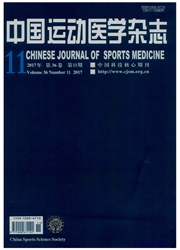

 中文摘要:
中文摘要:
目的:探讨fms样酪氨酸激酶(Flt-1)基因多态性与低氧训练敏感性的关联性。方法:选取70名中国北方平原地区汉族男子进行4周高住高练低训(HiHiLo),方案为每日在低氧环境(O2浓度为14.5%~14.8%,大约相当于海拔3000米)中休息10h,每周进行3次75%VO2max低氧训练(O2浓度为15.4%,大约相当于海拔2500米),其余时间在常氧下训练。测试其HiHiLo前后的VO2max及训练期间的血象指标。用PCR—RFLP法分析Flt-1基因SNP/A193019G多态性。结果:(1)4周HiHiLo后,AA基因型V02max增加幅度高于AG基因型57.54%,但无显著性差异。(2)在HiHiLo期间(除第23天外),AA基因型Hb的变化幅度始终高于AG基因型,但无显著性差异。结果提示,与AG基因型者相比,AA基因型者可能有对低氧训练更敏感的趋势。
 英文摘要:
英文摘要:
Objective To explore the characteristics of polymorphisms in the Fms-related tyrosine kinase-1 (Flt-1) gene of men of Han nationality in northern China and the sensitivity of Flt-1 to the hypoxic training. Methods Seventy healthy men of Han nationality in northern China underwent HiHiLo (living at high altitude - exercise at high altitude - training at low altitude) training for 4 weeks. Training programme was as follows: exposure in hypoxic environment (14.5 % - 14.8 %02, 10h/day), three times hypoxic training per week (15.4 % 02 ), and training at sea level. The genotype was analyzed by PCR-RFLP. Results (1) After 4-week HiHiLo training, /NVO2 max in men carrying AA increased 57.54%, as compared those carrying AG, but there were no significant differences in the genotypes. (2) During 4-week training, besides on 23^rd day, △Hb in men carrying AA was greater than in those carrying AG, but there were no significant differences in the genotypes. Conclusion Men carrying AA probably were more sensitive to the hypoxic training than those carrying AG.
 同期刊论文项目
同期刊论文项目
 同项目期刊论文
同项目期刊论文
 期刊信息
期刊信息
